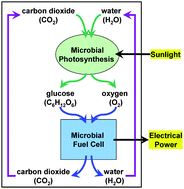Biologically-based approaches to large-scale solar power generation promise low cost durable technologies that will exhibit the self-repairing capabilities of photosynthetic organisms1–3 (Basic Research Needs for Solar Energy Utilization, U.S. Department of Energy, Washington DC, 2005; J. Barber and B. Andersson, Trends Biochem. Sci., 1992, 17, 61; A. Huijser et al., J. Phys. Chem. C, 2007, 111, 11726). Most proposed approaches however utilize photosynthetic proteins extracted from organisms4–6 (S. A. Trammell et al., J. Phys. Chem. C, 2007, 111, 17122; R. Das et al., Nano Lett., 2004, 4, 1079; E. Greenbaum, Science, 1985, 230, 1375) and forgo the self-repair capabilities of organisms resulting in short-lived power generation. Beginning with two non-descript graphite electrodes and marine sediment and seawater, we report here a proof-of-concept demonstration of a self-assembling and self-repairing microbial photoelectrochemical solar cell that generates electricity from sunlight7 (S. A. Licht, Nature, 1987, 330, 148). Time records of voltage and current generated by this solar cell reveal a circadian rhythm consistent with a photosynthetic nature. This result supports the interpretation that the electrode reactions are catalyzed by self-maintaining biofilms spontaneously formed on each electrode surface, and that the electrode reactants are photosynthetically regenerated from the electrode products by a self-maintaining spontaneously formed photosynthetic consortium. Our finding suggests a strait-forward approach toward durable biologically-based solar power generation.


 Please wait while we load your content...
Please wait while we load your content...